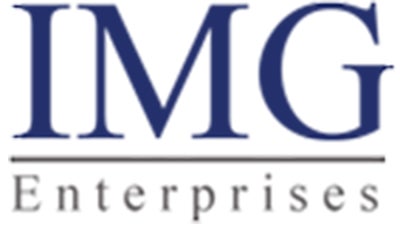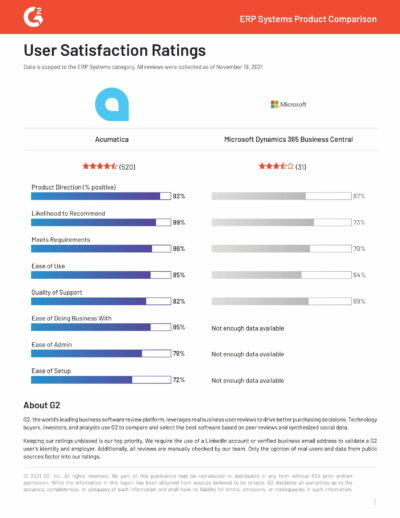Microsoft Dynamics SL (formerly Solomon) is a mid-market ERP product that integrates financial management specifically designed for project- and service-based companies.
Acumatica vs Microsoft Dynamics SL
Feature Comparison
| Functionality | Acumatica | Microsoft Dynamics SL |
|---|---|---|
| True cloud* (built for cloud) | ||
| Full function ERP | ||
| Full relational database export | ||
| Flexible licensing options based on customer requirements | ||
| Multiple deployment options | ||
| Scale as you grow | ||
| Superior Return on Investment (ROI) |
What are our customers saying after replacing a Microsoft Dynamics Product with Acumatica?
Background
While Microsoft Dynamics SL continues to be a very good mid-market ERP product, there are some drawbacks. For example:
- Dynamics SL still uses an aging client-server architecture, making it slow and clunky to use in a hosted (cloud-enabled) environment.
- Dynamics SL requires the purchase of additional Microsoft products (CRM, SharePoint, Project Server, etc.) to take full advantage of its capabilities.
- Dynamics SL’s much older system architecture becomes an issue in scenarios designed for the latest technologies, including cloud deployment options, customizations using current development tools, and integration with CRM.
- SL users can expect less innovation for their maintenance dollar. Microsoft has said, “Dynamics GP and Dynamics SL will continue to receive product improvements and updates, but the most benefit to these customers comes from upgrading to Dynamics 365 Business Central”
- SL has no direct migration path to Business Central, Microsoft’s only true-cloud mid-market ERP product. Moving to Business Central will be a new implementation on a different ERP.
Solomon was acquired by Great Plains Software in June 2000. Great Plains was subsequently acquired by Microsoft Corporation in May 2001. Microsoft has stopped actively marketing Microsoft SL. Currently, all the development and support for Dynamics SL has been outsourced.
Acumatica offers a completely integrated ERP and CRM solution and can be deployed on-premises or in the cloud. The cost for Acumatica is based on the price of system resources, not by the number of users, so you enjoy unlimited users as your company grows.
We believe Acumatica provides the best price/value, performance, functionality, and ease of use of any ERP product available for small- and medium-sized businesses. We encourage you to perform due diligence when considering the purchase of any ERP system, not just ours. Ask questions. Know your business requirements over the next three to five years. We want to make sure you get the ERP system that is right for your company now and in the future.
NOTE: John Howell was the CEO of Solomon from 1983-1999 and the co-founder of Acumatica. Those that like the functionality of Dynamics SL will find many similarities with Acumatica.
See the G2 Crowd survey showing how users compared Acumatica against Microsoft Dynamics NAV, GP, and 365.
Make sure you take some time to review Acumatica’s ERP software selection resources to help you find the solution that is right for you.
Watch this quick (3 minute) demonstration of Acumatica in action.
Differentiators
“True cloud” means all functionality is accessible through the internet using a standard browser without the need for any additional software installation on the user’s device or additional software licensing. Acumatica works on-premises or in the cloud without additional equipment or software. Dynamics SL requires Microsoft SharePoint as a frontend for it to run in the cloud. Currently, the only true cloud option offered by Microsoft for SL users today is to give up SL entirely and reimplement (at significant expense) with Microsoft Dynamics 365 Business Central (formerly Dynamics NAV).
Technically, both products support cloud, on-premises, and hybrid configurations. However, Acumatica supports all three deployment options natively using a browser to access the system. Dynamics SL, on the other hand, requires SharePoint as a front-end to enable a cloud configuration. In addition, SharePoint requires user licensing, increasing TCO.
When choosing an ERP solution, you must consider not just your company’s current needs, but the future needs as well. Both products allow you to scale resources to support a growing company, but because Acumatica only charges by the computing power required and not by users, you can scale your equipment as you grow, allowing an unlimited number of users to access the system regardless of job function. Dynamics SL, on the other hand, incurs greater costs as your company grows and more employees need access to the system. Be aware of these costs and consider them in your final evaluation.
Acumatica has a much broader feature set than SL (e.g., payroll, warehouse management, industry-specific capabilities, document management, field service management, and more), which minimizes licensing, integration, and maintenance fees for 3rd party applications. Acumatica also charges by computing power used, not by user. Dynamics SL charges per user and these costs increase as your company grows. Further, Acumatica works natively in the cloud, while Dynamics SL requires a separate license for SharePoint for it to be cloud-enabled.
 Canada (English)
Canada (English)
 Colombia
Colombia
 Caribbean and Puerto Rico
Caribbean and Puerto Rico
 Ecuador
Ecuador
 India
India
 Indonesia
Indonesia
 Ireland
Ireland
 Malaysia
Malaysia
 Mexico
Mexico
 Panama
Panama
 Peru
Peru
 Philippines
Philippines
 Singapore
Singapore
 South Africa
South Africa
 Sri Lanka
Sri Lanka
 Thailand
Thailand
 United Kingdom
United Kingdom
 United States
United States



